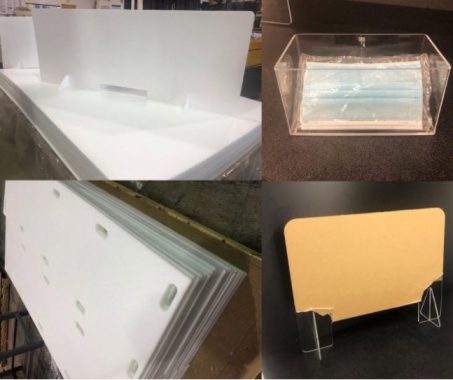Safety has become one of the prime concerns for people across the globe post-COVID-19. Infection prevention has become important than ever. Hand sanitation and wearing personal protective equipment (PPE) is being promoted as one of the important infection prevention measures. The PPE usually comprises garments that are used by healthcare professionals to avoid infections while caring for infected persons or while working in laboratories dealing with bodily fluids. As COVID-19 is considered an airborne infection, WHO and FDA recommends healthcare professionals to use specialized PPE such as face shields, goggles, gloves, head cover, gown, and rubber boots. Except for rubber boots, the rest PPE products are made of plastic. The plastic material for PPE must be chosen based on quality, environment and needed specifications. Of all PPE, the face shields have invigorated the interests of users. This is because they cover the face and are made of clear materials. Additionally, several new accessories such as face mask dispensers, face mask comfort clips and sneeze guards have also gained popularity. Like face shields, these virus barrier solutions are also made of clear materials. What are the popular clear plastic materials used for building these PPE Plastic solutions? Read the post to know answers.

Although most of the below discussed solutions existed before, they have gained importance during the pandemic.
• Face Shield: According to the US Centers for Disease Control (CDC), the face shield is a transparent plastic that is used as a substitute for goggles or a mask. It covers the entire face – right from the forehead to the chin and sides of the face. These face shields protect health care professionals from bodily fluids that may contain droplets of a patient’s cough or sneeze.
• Face Mask Dispensers: They are used in healthcare facilities for storing disposable face masks. Usually, face mask dispensers are installed in places where they can be easily seen, accessed, and re-stocked whenever necessary. Facemask dispensers are also used in various restaurants and commercial facilities, too.
• Face Mask Comfort Clips: Wearing a face mask properly around the nose and mouth is critical to the containment of personal droplets. The mask is typically secured around the ears. The mask does not adjust or well to an individual’s head size and can cause long wear time discomfort and bruising in and around the ears. Face mask comfort clips allow for mask adjustments that ensure correct face mask usage and allows hearing aid users the opportunity to actually wear a face mask with their hearing aids in place.
• Sneeze Guards: They have been popular but have recently invigorated interests of users across the world. These guards are used as defensive barriers in healthcare and other environments to protect staff, patients, or customers from airborne infections.
All the above-mentioned PPE plastic solutions are made of materials, which are not only clear but also antimicrobial, user-friendly, and cost-effective. The following are a few popular plastic materials used for making face shields, face mask dispensers, and sneeze guards.
• Acrylic Sheets: Acrylic is the popular choice for making all the clear plastic PPE solutions mentioned here. This material is chosen because it assures durability, excellent formability, and price advantage, too. Sneeze guards and face mask dispensers made of acrylic also offer scratch resistance, which makes them an ideal choice of material over types of plastic. Nowadays, face mask made of modified acrylic sheets are also gaining popularity.
• Polycarbonate Sheets: This is another popular plastic material for personal protective equipment like face shield and face mask dispenser. Polycarbonate assures high optical clarity. The material can be easily molded and thermoformed. It can be hot or cold formed. The material is lightweight and tamperproof and resilient than acrylic. Sneeze guards made of polycarbonate are considered ideal alternative to acrylic sheets, but they are less scratch resistant. Polycarbonate face shields are proven to protect users from particles, splashes, and flying debris. In April 2020, there has been news on Massachusetts Institute of Technology’s (MIT) mass producing flat-packed disposable face shields for medical workers. Usually made of a single sheet of plastic, these shields were produced flat and could be folded into three-dimensional structures whenever required. Also, the face shields made of polycarbonate sheets are compatible with a variety of sanitizers and disinfectants.
• Polyester: This is one of the primary plastic materials for PPE components. It is used to design disposable face shields. The material exhibits excellent chemical resistance, and is durable and tough. The dimensional stability of this material makes it an ideal choice for various applications.
• PETG: Polyethylene terephthalate glycol (PETG) is an FDA grade material and offers excellent impact resistance, chemical protection, and visual clarity. PETG has been one of the important plastic materials for personal protective equipment like goggles for use in various medical applications, because they are customizable and cost-effective. The goggles made of these sheets are also widely used for educational and other similar applications.
Along with knowing the best plastic materials for personal safety equipment (PPE), it is important to get them manufactured or machined by a trusted manufacturer. Ehren-Haus Industries, Inc. is an experienced company offering design, manufacturing, CNC plastic machining and fabrication of PPE solutions to order. It has been supporting its medical industry clients by providing virus management and other medical solutions such as enclosures or dividers, face mask dispensers, sneeze guards, virus barriers, patient transfer boards, coroner and mortuary body boards, before and in response to the COVID-19 outbreak.
Contact Ehren-Haus Industries by phone or email for your virus management solutions